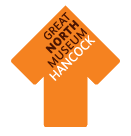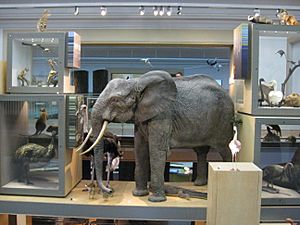Great North Museum: Hancock facts for kids
 |
|
 |
|
| Established | 1884 |
|---|---|
| Location | Newcastle upon Tyne, England |
| Type | Natural history museum |
| Visitors | 638,454 (2009) |
| Owner | Natural History Society of Northumbria |
| Public transit access | Haymarket Metro/Bus station |
| Great North Museum | |
|
|
The Great North Museum: Hancock is a super cool museum in Newcastle upon Tyne, England. It's packed with amazing things from natural history and ancient cultures.
This museum first opened its doors in 1884. It used to be called the Hancock Museum. Later, in 2006, it joined up with two museums from Newcastle University. These were the Museum of Antiquities and the Shefton Museum. Together, they became the Great North Museum.
After a big makeover, the museum reopened in May 2009. It kept the "Hancock" name to honor its past. The Natural History Society of Northumbria owns most of the museum's collections. North East Museums helps manage it for Newcastle University.
Contents
Discover the Great North Museum: Hancock
This museum is a fantastic place to explore. You can learn about dinosaurs, ancient Egyptians, and animals from all over the world. It's a journey through time and nature!
Where is the Museum?
You can find the museum right on the campus of Newcastle University. It's near a main road called the Great North Road. The easiest way to get there is by public transport.
The Haymarket Metro station is very close. There's also a bus station nearby. Underneath the museum grounds, there's even an old entrance to the Victoria Tunnel. This tunnel was used as an air raid shelter during World War II.
A Journey Through Time: Museum History
The museum's story began a long time ago, around 1780. A man named Marmaduke Tunstall started collecting interesting items. He gathered things about different cultures and nature from around the world.
How the Collection Started
Tunstall brought his collection from London to North Yorkshire. After he passed away in 1790, George Allan bought it. Later, in 1823, the Literary and Philosophical Society of Newcastle upon Tyne took over the collection.
One of the oldest items you can still see is a wombat. It was the first complete wombat ever brought to Europe! In 1829, a group called the Natural History Society was formed. They were a scientific spin-off from the Literary and Philosophical Society.
A New Home and Name
The Natural History Society's collection grew too big for its first small museum. So, a new museum opened on the current site in 1884. A generous person named William Armstrong gave a lot of money to help build it.
In the 1890s, the museum was renamed. It honored two local Victorian naturalists, Albany Hancock and John Hancock. That's where the "Hancock" name comes from!
Since 1959, Newcastle University has helped look after the building and collections.
The Big Reopening: Great North Museum
The Hancock Museum closed on April 23, 2006, for a huge renovation. It reopened on May 23, 2009, as the Great North Museum: Hancock. This big project cost £26 million!
Many different groups worked together to make it happen. These included Newcastle University and the Heritage Lottery Fund. The building's architect, Sir Terry Farrell, grew up in Newcastle.
What's New Inside?
The new museum has exciting displays on many topics. You can explore natural history and geology. There are also sections on Ancient Egypt and Ancient Greece. You can learn about Romans and Hadrian's Wall.
Other areas cover World Cultures and Pre-history. The museum also has a fun, interactive study zone. There's a special space for kids under five and a digital Planetarium. It's a great place for learning and discovery!
The new museum brought together collections from other university museums. This made the Great North Museum even bigger and better.
Celebrating the Reopening
In September 2008, the museum looked for someone who looked like Emperor Hadrian. They wanted a photo for a permanent display. The museum officially reopened on May 23, 2009.
It quickly became very popular. By August 2009, over 400,000 people had visited! On November 6, 2009, HM The Queen officially opened the museum. By the end of 2009, over 600,000 people had visited.
By August 2010, the museum had welcomed its one millionth visitor!
Amazing Collections and Exhibits
The museum is home to many incredible things. You'll find a life-size model of an African elephant. There's also an Egyptian mummy named Bakt-en-Hor.
Meet the Stars of the Museum
One of the biggest stars is a full-size replica of a T-Rex skeleton! You can also see Sparkie, Newcastle's famous talking budgie. He was preserved after he passed away in 1962. Another Egyptian mummy, Irtyru, is also on display.
The huge African elephant model was made by Zephyr Wildlife. They took a cast from a real stuffed elephant in Germany. A crane was needed to get it into the museum! The T-Rex model came all the way from Canada. It was one of the first big items placed in the new museum.
More Exciting Displays
Other exhibits include 'Hadrian's Wall', showing Roman life in northern England. 'Natural Northumbria' focuses on local wildlife. 'Ancient Egypt' explores Egyptian history and features the mummies.
'Ice Age to Iron Age' tells the story of the British Isles over 12,000 years. 'World Cultures' displays artifacts from around the globe. 'The Shefton Collection' has a detailed collection of Greek items. 'Explore' is a hands-on area with interactive sessions.
The interactive Bio-Wall lets you learn about hundreds of creatures. You can find out where they live, from the Arctic to the Desert. There's also a great white shark display. You can see polar bear and giraffe specimens. A moa skeleton is also on view.
From May to October 2019, the museum hosted Dippy the dinosaur on its UK tour. The museum's archives also hold beautiful 19th-century botanical paintings. These show plants from the Newcastle and Scottish Borders region.
The Museum Library
The Great North Museum Library is open to everyone. It's on the second floor of the Hancock building. It holds three important collections. These include the libraries of the Natural History Society of Northumbria and the Society of Antiquaries of Newcastle upon Tyne. It also has Newcastle University's Cowen Library.
Important People at the Museum
- Anthony Michael (Tony) Tynan, Curator from 1958 to 1992
- Dr Albert George Long, Deputy Curator from 1966 to 1980
See also
- Abel Chapman, a Victorian 'hunter-naturalist' whose animal trophies are at the museum.





